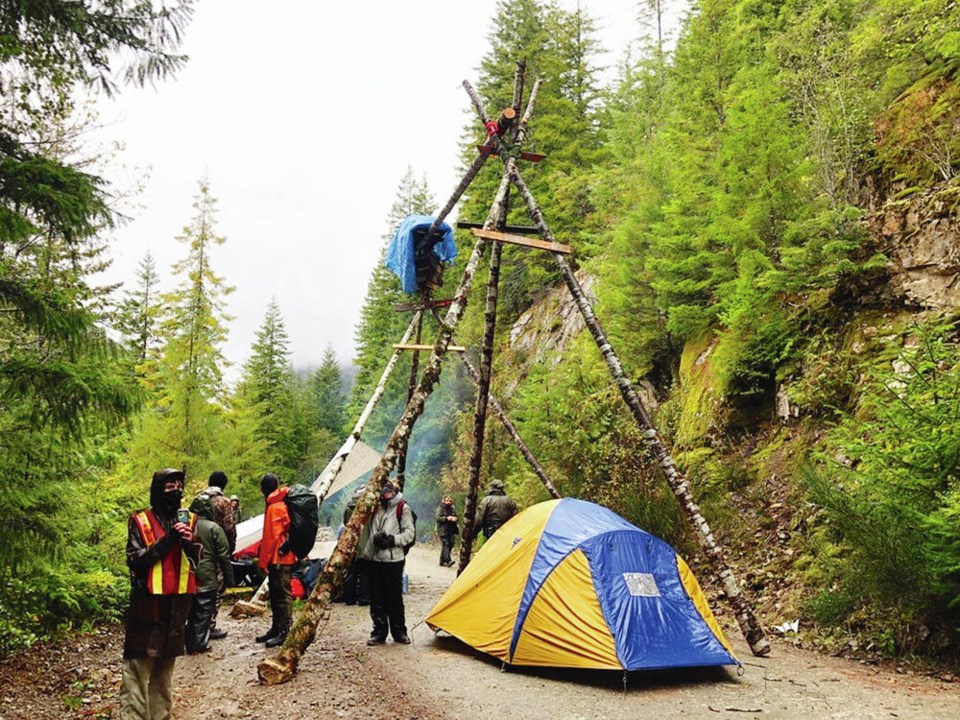PORT RENFREW — Three days since returning to the Fairy Creek area to enforce a court injunction against old-growth logging protesters blocking roads, the RCMP says it has cleared an entire road for industry vehicles.
Through patches of heavy rain Wednesday, officers cleared two tripod structures after removing people perched several metres above the ground on Granite Mainline Forest Service Road.
They also removed obstacles Monday and Tuesday, including tripod-like structures and people locked into the road, after weeks of relative quiet since a court injunction against the blockades ended in late September.
A B.C. Court of Appeal judge has since reinstated the injunction, pending an appeal by Surrey-based forestry company Teal Jones Group, which has government approval to log in the area. Officers resumed enforcement of the injunction Monday.
The removal of the second tripod Wednesday left the 12-kilometre logging road clear of obstructions, said Gilles Deziel, a media relations officer for the B.C. RCMP.
At the end of the road is what protesters call Heli Camp, where forestry workers are trying to harvest trees, he said.
“What we’ll be doing now, we’re just going to be patrolling the road 24/7 to make sure there’s no other obstructions so we can get the loggers back on the road and back to doing their harvesting as per the injunction,” Deziel said.
It may not mean the end to blockades on the road, as officers have seen obstacles spring up after clearing roads in the past, Deziel said, but there are more officers working overnight to prevent the creation of new obstructions than there were during enforcement from May to September. Officers are just focused on this road at the moment, he said.
A protester who goes by the camp name Raven said she was still feeling hopeful after watching the obstacles come down Wednesday.
The blockades are far from over, she said. “It’s not going anywhere, no matter what they do. I hope that the government and the police realize that and maybe, hopefully, we can start working in a way that’s more efficient.”
Raven said she hopes people are paying attention to the protests and thinking about their role in mitigating climate change.
“We’re a ticking time bomb, and whether or not humans are on the Earth, the world goes on. However, it would be really cool if human technology can better the world, rather than impact it in a negative way,” she said.
While arrests remained peaceful, Raven said protesters continue to be concerned about aggressive tactics by police and believe Indigenous protesters are subjected to harsher treatment.
The RCMP has made some changes in response to criticism of enforcement methods in a September ruling by Supreme Court Justice Douglas Thompson. The judge cited an order for officers to remove individual identification as one way in which RCMP command decisions were damaging the court’s reputation, arguing the removal of identification makes the complaint process more difficult, renders officers anonymous and increases the temptation for officers to stray from professional conduct. “We identify ourselves. Accountability requires it,” he wrote.
Officers enforcing the injunction Wednesday covered their name badges with duct tape, on which they had written numbers by hand. Deziel said the numbers are not badge numbers, but are specific to an officer, similar to an employee number. He said officers have been harassed online, including having their addresses shared publicly, and covering names with the numbers identifies the officers while protecting them from potential threats.
At least one officer Wednesday was wearing a “thin blue line” patch — a muted Canadian flag with a horizontal blue line — despite Thompson delivering a rebuke in his ruling of the “regrettable RCMP decision” not to enforce the department’s policy against wearing the unapproved patch while enforcing a court injunction.
While officers say they wear the symbol to honour officers who have died on the job, it’s seen by some as divisive, pitting police against the people they’re intended to serve.
While the RCMP told officers last fall they’re not to wear the patch, the union representing officers has promised to defend any member who faces discipline for wearing it.
Asked why an officer was wearing the patch Wednesday, Deziel said: “The RCMP has a policy. There’s also the union, the [National Police Federation], also has a policy, which has been taken to the senior level for a decision, and that’s about it.”
Access for journalists had improved Wednesday compared to the early summer, with exclusion zones close enough to watch as officers cut away planks of wood and drilled into a concrete block to remove a person from the top of a tripod.
Officers had made 1,124 arrests in the Fairy Creek area as of Tuesday.



